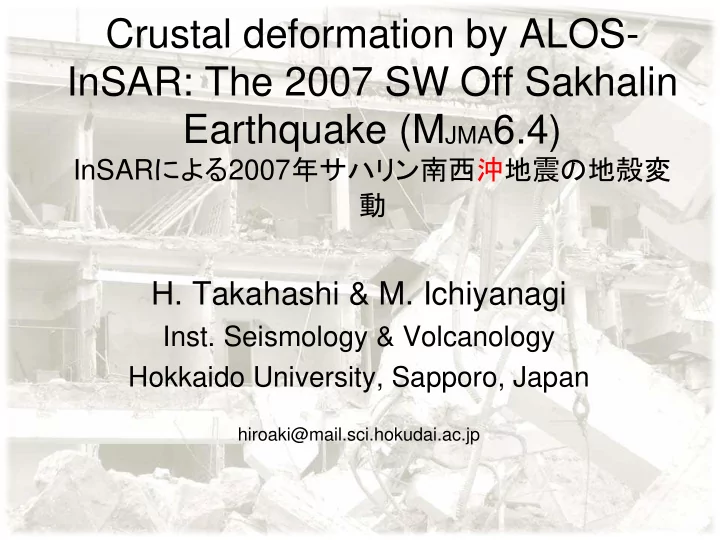

Crustal deformation by ALOS- InSAR: The 2007 SW Off Sakhalin Earthquake (M JMA 6.4) InSAR による 2007 年サハリン南西沖地震の地殻変 動 H. Takahashi & M. Ichiyanagi Inst. Seismology & Volcanology Hokkaido University, Sapporo, Japan hiroaki@mail.sci.hokudai.ac.jp
Tectonic Setting: Plate kinematics Heki et al., 1999 Amurian-Okhotsk boundary: ~1cm/yr EW convergence
Seismic & Geological data Focal mechanisms & Fault zonesGeological fault and regional tectonics 2007 M6.4 Fournier et al., 1994 • EW P-Axis reverse fault mechanisms • N-S trending geological fault system Geodetic data=Seismic data=Geological data
GPS velocity in S. Sakhalin & N. Hokkaido 2007 2007 Vasilenko et al., 2004 F2 data from GSI ~1cm/yr convergence rate along S. Sakhalin and N . Hokkaido line
The 2007 Earthquake Depth: •GCMT: 12km •JMA-CMT: 10km •USGS: 14.1km USGS •HU: 12km Dip: GCMT •GCMT: 48deg Hokkaido U •JMA: 43deg •USGS: 49deg JMA CMT M JMA : 6.4 Mw: 6.2 Hokkaido U.: 6.2 Hypo data from JMA EW P-axis reverse fault
Damaged buildings Intensity: 7-8 ( MSK)(JMA=5+~6-) Death: 2 Photos by Lomtev et al., 2007 and Institute of Marine Geology and Geophysics, Russian Academy of Scienc
Aftershocks Meca from GCMT M>4.0 20km Source region: 30*10km^2 Depth: 5-13km Aftershock region come on shore in the southern edge
Uplifting along the coast line Photo by : Lomtev et al., 2007 and Institute of Marine Geology and Geophysics, Russian Academy of Science
Uplifting region 70cm By Takahashi’s obs. Photo and Data from • Lomtev et al., 2007 • Institute of Marine Geology and Geophysics, Russian Academy of Sciences Visible uplift: •70cm upheavals are observed by organic remains (seaweeds). •Only southern part of aftershock region.
ALOS data analysis ALOS-PALSAR data •Path: 397, Frame: 920-930 •Master: 2007/06/28 •Slave: 2007/08/13 •Ascending •Bp=254m •Off-nadir angle: 34.3deg Software •SIGMA-SAR ver. 480- 07090301 by JAXA-Shimada (1999). •SRTM
Acknowledgements • We are grateful to Dr. M. Shimada, JAXA, for the use of his SIGMA-SAR interferometry software [M. Shimada, 1999], and Dr. Y Miyagi, JAXA, for valuable comments.
Interferometric SAR image 10km Satellite slight direction 6/28-8/13 (EQ:8/2) Coseismic signal was clearly observed
Aftershocks & Crustal deformation Hokkaido U. Catalogue JMA Catalogue Aftershock region by Hokkaido U. fit well with the InSAR data
Uplifting and InSAR image: Local area 1km Valley Lomtev et al., 2007 Visible uplifting region = InSAR observation
Fault model estimation… Preliminary… Data •Aftershocks 10km •InSAR deformation •GCMT parameters
Obs. and Calc. -Single fault model- From GCMT Strike:184,Dip:48,Slip:91 Contour: 5cm LOS change
Double fault Strike: 200, Dip: 48 Slip: 91 10km LW: 25km*11km D: 4km, U=1.4m Strike: 170, Dip: 48 Slip: 91 LW: 10km*11km D: 4km, U=1.4m
Obs. Vs Calc. 12cm 27cm Contour: 5cm LOS change Well explain observed data
Detailed shot 15 5 Obs. 70cm 10 Calc. 55cm 0 Uplift by land survey LOS change Calculated UD displacement Not well explained
Mw, Rigidity, Source process L=35km! M,Mw JMA Hokkaido U. GCMT Rigidity (10GPa) Very small rigidity? From GCMT: Mw6.2 mb5.3 Half duration: 3.0sec Centroid-Hypocenter: 8.7sec Another factors? Gas & Oil?
Intensity data Mainshock: Mw6.2, mb5.2 Largest aftershock: Mw5.8, mb5.6 10km Mainshock Largest A.F. Mw 6.2 5.8 mb 5.3 5.6 Largest Intensity 2 3 Felt region Narrow Wide Anomalous source process?
Summary • InSAR deformation well fit with well-defined aftershock region. • InSAR deformation well fit with visible uplift region along the coast line. • InSAR deformation is roughly explained by double fault model. • InSAR & aftershock region show possible very small rigidity and/or another factor to explain the large deformation in the south.
Recommend
More recommend